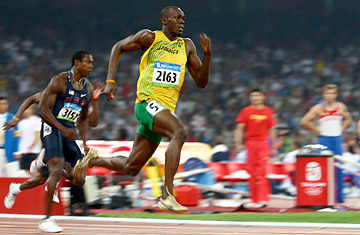
Jamaica's Usain Bolt runs a world record time in the men's 200m at the Beijing 2008 Olympics.
Usain Bolt may have just broken the human speed limit. Last week, he took two gold medals in the Olympic 100m, shattering his own world record with a time of 9.69 secs., and the 200m with a time of 19.3 secs., obliterating by two-hundredths of a second the long-standing world record Michael Johnson set at the Atlanta Games in 1996.
Bolt is an exciting showman and, clearly, a gifted runner, but is he an inimitable oddity, or proof that athletes are simply getting faster overall? World speed records have fallen like dominoes at these Olympic Games (in swimming too, you may have heard), and experts think humans can get faster still. Half a century or ago or so, we didn't believe a human could run a 4-min. mile — until Roger Bannister proved us wrong in 1954 when he ran it in 3 mins. 59.4 secs. At the 1936 Games in Berlin, sprinter Jesse Owens won the 100m gold with a blistering time of 10.3 secs — today, that's par for junior level speed athletes. We now have better equipment, better training and improved nutrition, along with faster tracks and, crucially, a lot more endorsement money to be made by running as fast as possible, and that's uncovered a deeper pool of better runners than ever before.
Elite sprinters are not, however, simply improved versions of the average Sunday runner. They are physiologically different. For example, a typical human has in his skeletal muscles an equal balance of "fast-twitch" muscle fibers (quick contracting, easily fatigued muscle tissue that generates high power) and "slow-twitch" fibers (the muscle mass that uses oxygen — aerobic, rather than anaerobic), on which endurance runners rely. Slow-twitch muscle can contract for long periods of time with less fatigue, which helps some distance athletes run up to 60 mi. per day. Sprinters legs are genetically blessed with 70% fast-twitch and 30% slow-twitch muscles, which is what allows them to push off so fast and so powerfully, according to Scott Trappe, who heads the human performance laboratory at Indiana's Ball State University and has studied sprinters' muscles. But elite sprinters like Bolt may have even more of something that other world-class sprinters don't: superfast-twich muscles, which perform at double the rate of regular fast-twitch muscles, creating even more force. Trappe says regular folks have 1% to 2% superfast-twitch skeletal muscle mass, but in a sprinter like Bolt, that figure may be up to 25%.
That helps explain why Bolt's legs move fast enough to be a blur. When people run, they are essentially bouncing though the air from one leg to another, says Daniel Lieberman, a professor of biological anthropology at Harvard University who studies how and why the human body looks and works as it does. What determines how fast people go is their stride length — a function of how long the legs are, how powerfully they push off into a stride and how far forward the body jumps — and their stride rate, which is how fast they can propel their legs forward. While great endurance runners, get their speed from long strides, sprinters get much of their speed from a fast stride rate — and from raw power. They hit the ground harder, relative to their body weight, than marathoners.
It appears that Bolt takes advantage of a little of both. At 6 ft. 5 in., he's nearly half a foot taller than many other gold-medal sprinters; compared to his Olympic competition, Bolt's step was 1 ft. longer, allowing him to cover 100m in 41 steps. The other athletes needed, on average, 47. That helps, considering Bolt isn't the best starter — he's relatively slower off the block, but he separates himself at the end of the race, when "he's still able to turn his legs over fast enough with high power," says Ed Coyle at the University of Texas's Human Performance Laboratory. "He overcomes his average start and just doesn't slow down, as others do, in the last 30 to 40 meters. He's able to relax and coordinate his longer legs."
Looking forward, "no one can really know exactly how fast a human may be able to run," says Dennis Bramble, professor of biology at the University of Utah. Certainly, runners have been getting faster, as far as we know, but as Peter Weyand, an expert in biomechanics at Southern Methodist University, points out, our history of recorded time in sprints is relatively brief. "We have no way of knowing if humans might not have been even faster centuries or millennia ago," he says.
"Modern sprinters seem to be operating close to the limits of the human body," says Bramble. "Still, when someone who is not built like a classic sprinter — [Bolt is] taller and leaner than most — smashes the world record while making it look easy, maybe all bets should be off."
